Kinematic and Dynamic Characteristics of the Free-Floating Space Manipulator with Free-Swinging Joint Failure
Abstract
For the free-floating space manipulator with free-swinging joint failure, motions among its active joints, passive joints, free-floating base, and end-effector are coupled. It is significant to make clear all motion coupling relationships, which are defined as “kinematic coupling relationships” and “dynamic coupling relationships,” inside the system. With the help of conservation of system momentum, the kinematic model is established, and velocity mapping relation between active joints and passive joints, velocity mapping relation between active joints and base, velocity mapping relation between active joints and end-effector. We establish the dynamic model based on the Lagrange equation, and the system inertia matrix is partitioned according to the distribution of active joints, passive joints, and the base. Then, kinematic and dynamic coupling relationships are explicitly derived, and coupling indexes are defined to depict coupling degree. Motions of a space manipulator with free-swinging joint failure simultaneously satisfy the first-order nonholonomic constraint (kinematic coupling relationships) and the second-order nonholonomic constraint (dynamic coupling relationships), and the manipulator can perform tasks through motion planning and control. Finally, simulation experiments are carried out to verify the existence and correctness of the first-order and second-order nonholonomic constraints and display task execution effects of the space manipulator. This research analyzes the kinematic and dynamic characteristics of the free-floating space manipulator with free-swinging joint failure for the first time. It is the theoretical basis of free-swinging joint failure treatment for a space manipulator.
1. Introduction
The application of a space manipulator can not only improve execution efficiency of space tasks but also decrease risks of an astronaut’s EVA. Therefore, space manipulators play an important role in space exploration [1, 2]. However, space manipulators are exposed to hazardous space environment with high temperature difference and intense radiation and usually execute many heavy tasks, like carrying a load whose mass reaches up to 8-25 tons, so parts in joints suffer from severe abrasion, and joints are prone to fail during the long-term service [3]. Subjected to hazardous environment, maintaining fault joints in orbit is accompanied with high costs and risks, so we hope to design a failure treatment strategy to keep using space manipulators after joint failure [4, 5].
Wu et al. [6] divided joint failure of space manipulators into two types: a fail-on type with infinite torque and a fail-off type with zero torque, according to joint failure cases in Canadarm1. Afterwards, these two failure types are explicitly defined as locked joint failure and free-swinging joint failure [7, 8]. Locked joint failure means the fault joint is rigidly locked so long as the abnormal operation is detected. Reconfiguring the kinematic and dynamic models, the space manipulator with locked joints is degraded into a new manipulator with less degrees of freedom (DOF) to be used [9, 10]. Free-swinging joints cannot support torque at all, so they swing freely. It is usually caused by motor excitation loss, gear engagement separation, or cracking of the transmission shaft in alternant speed-up and speed-down. However, there are few researches on free-swinging joint failure treatment for space manipulators [11].
For the space manipulator with free-swinging joint failure, its DOF is larger than the number of actuated joints, so it is an underactuated system. Referring to the service experience of underactuated manipulators on the ground, we conclude that free-swinging joint failure treatment methods mainly include the following: (1) direct control of underactuated manipulators to execute tasks [12]; (2) with the help of the kinematic and dynamic coupling relationships between active joints and passive joints, free-swinging joints are passively regulated to target angles and are locked. Then, the manipulator with locked joints comes into use [13]. Because free-swinging joints can only be regulated passively, they are called as “passive joints,” and the healthy joints regulating passive joints are called “active joints.” The free-swinging joint failure treatment methods above either depend on motion planning or depend on the control method. No matter which method is used, it is significant to establish kinematic and dynamic models of underactuated manipulators and analyze kinematic and dynamic characteristics to make clear all coupling relationships inside the system at the beginning.
Kinematic and dynamic characteristic analysis has been extensively studied around underactuated manipulators on the ground. Aiming at a 2 DOF planar manipulator whose second joint is passive, Nakamura et al. [14] established its dynamic model based on the Hamiltonian function in phase space. Introducing periodic motion into an active joint, he drew Poincaré mapping figures to show the displacement relation between an active joint and a passive joint. Arai et al. [15] derived the unintegrable acceleration coupling relationship between active joints and a passive joint of a 3 DOF underactuated planar manipulator. The acceleration coupling relationship was called as “dynamic coupling relationship,” and it was the second-order nonholonomic constraint inside system. Lai et al. analyzed the dynamic coupling relationships of 2 DOF [16, 17], 3 DOF [18], 4 DOF [19], and n DOF [20] underactuated planar manipulators with the passive first joint and pointed out that when the first joint is passive, the second-order nonholonomic constraint could be integrated into the first-order nonholonomic constraint, so velocities of active joints and a passive joint were coupled. The researches above tell us that for underactuated planar manipulators, if only the first joint is passive, the underactuated system is with the first-order nonholonomic constraint, which represents that velocities of active joints and passive joints are coupled. Otherwise, the second-order nonholonomic constraint exists, and accelerations of active joints and passive joints are coupled.
The researches above used many geometric constraints of planar mechanism to simplify the analysis procedure, so they are only appropriate for underactuated planar manipulators. High DOF manipulators have three-dimensional geometric structure, so their kinematic and dynamic characteristic analysis is more complicated. Considering balance of gravity, English and Maciejewski [21] established the velocity mapping relation between joints and end-effector for n DOF underactuated manipulators. Bergerman and Xu [22] derived the second-order nonholonomic constraint which contained centrifugal force, Coriolis force, and gravitational torque and defined the local and global dynamic coupling indexes to depict acceleration transmission efficiency from active joints to passive joints, namely, dynamic coupling degree. Analysis of high DOF underactuated manipulators on the ground must consider gravity effects. However, the space manipulator is free from gravity. Mukherjee and Chen [23] established a dynamic model of the space manipulator with free-swinging joints through the Lagrange equation and derived dynamic coupling relationship between active joints and passive joints based on the Hamiltonian operator. Aiming at the case that active joints are more than passive joints, He et al. [24] pointed out that “passive redundancy” existed when regulating passive joints. Then, they designed a sliding-mode controller with end-effector position/attitude correction, to minimize end-effector disturbance when regulating passive joints. Chen et al. [25] analyzed dynamic coupling relationship between an adjacent active joint and a passive joint for a space manipulator with single free-swinging joint failure and proposed a passive joint regulation strategy based on iteration control. The researches above treated the space manipulator base as fixed. In practice, space manipulators are installed on a free-floating base and motions between joints and the base are coupled. This coupled motion will act on kinematic and dynamic modelling. If it is neglected, we cannot establish valid kinematic and dynamic models and cannot reveal kinematic and dynamic coupling relationships of the space manipulator with free-swinging joint failure.
For the free-floating space manipulator, motion between the base and joints satisfies the first-order nonholonomic constraint originally because of momentum conservation without external force [26]. Moreover, according to existing researches about kinematic and dynamic modelling for underactuated manipulators, the second-order nonholonomic constraint also exists in accelerations among active joints, passive joints, and the base. Therefore, the free-floating space manipulator with free-swinging joint failure simultaneously contains the first-order nonholonomic constraint (kinematic coupling relationships) and the second-order nonholonomic constraint (dynamic coupling relationships), and they are independent. However, for underactuated manipulators on the ground, either the first-order nonholonomic constraint or the second-order nonholonomic constraint exists inside systems. Therefore, the kinematic and dynamic characteristic analysis of the free-floating space manipulator with free-swinging joint failure is more complicated than conventional underactuated manipulators, and all kinematic and dynamic coupling relationships need to be studied.
- (1)
The general kinematic and dynamic modelling procedure of the free-floating space manipulator with free-swinging joint failure is proposed for the first time
- (2)
We point out that the free-floating space manipulator with free-swinging joint failure simultaneously contains the first-order and second-order nonholonomic constraints, and we explicitly reveal all kinematic and dynamic coupling relationships among active joints, passive joints, free-floating base, and end-effector
- (3)
We simply design motion planning and the control method based on the kinematic and dynamic coupling relationships for the free-floating space manipulator with free-swinging joint failure, and many tasks can be completed successfully
The remainder of this paper is as follows: Section II is the kinematic modelling of the free-floating space manipulator with free-swinging joint failure, and the velocity mapping relations between active joints, passive joints, base, and end-effector are derived. Then, we establish the partitioned dynamic model based on the Lagrange equation in Section III. In Section IV, all kinematic and dynamic coupling relationships inside the system are derived, and the local and global coupling indexes are defined. Then, motion planning and control methods for the free-floating space manipulator with free-swinging joint failure to execute tasks are designed. In Section V, simulation experiments are carried out to verify the existence and correctness of the first-order and second-order nonholonomic constraints and to display the execution effects of many tasks of the free-floating space manipulator with free-swinging joint failure. The conclusion is in Section VI.
2. Kinematic Modelling of the Free-Floating Space Manipulator with Free-Swinging Joint Failure
In this section, the kinematic model of the free-floating space manipulator with free-swinging joint failure is established and the expression of the conservation of system momentum is derived. Then, the velocity mapping relations between active joints, passive joints, the base, and end-effector are obtained.
2.1. Kinematic Modelling
An n DOF space manipulator with free-swinging joint failure is in Figure 1. In this paper, vectors and matrixes with subscript in the upper left corner are with respect to the corresponding coordinate frame and others with no subscript in the upper left corner are with respect to the inertial coordinate frame. Definitions of frequently used variables are as follow:
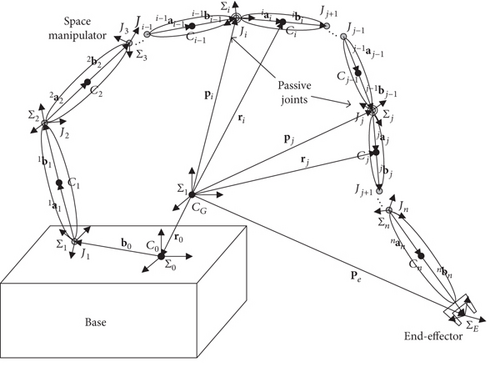
C0: base centroid,
Ci: centroid of the i-th link,
CG: centroid of the whole system,
Ji: i-th joint, i = 1, 2, ⋯, n,
∑I: inertial coordinate frame built at CG,
∑0: base coordinate frame built at C0,
∑i: i-th link coordinate frame built at Ci,
∑E: end-effector coordinate frame,
m0: base mass,
mi: mass of the i-th link,
M: mass of the whole system,
I0 ∈ R3×3: base inertia matrix with respect to C0,
Ii ∈ R3×3: inertia matrix of the i-th link with respect to Ci,
pi ∈ R3×1: position vector of Ji, i = 1, 2, ⋯, n,
: position vector of end-effector,
: attitude vector of end-effector,
ri ∈ R3×1: position vector of Ci, i = 1, 2, ⋯, n,
rg ∈ R3×1: position vector of CG (if ∑I is built at CG, rg ≡ 0),
r0 ∈ R3×1: position vector of C0,
Ψ0 ∈ R3×1: attitude vector of base,
b0 ∈ R3×1: position vector from C0 to J1,
: joint angle vector,
: joint velocity vector,
: joint acceleration vector,
: state variable of system ( and are velocity and acceleration, respectively),
: attitude transformation matrix from ∑j to ∑i,
: position vector from Ji to Ci (ai is its norm, i = 1, 2, ⋯, n),
: position vector from Ci to Ji+1 (bi is its norm, i = 1, 2, ⋯, n),
zi ∈ R3×1: unit vector of the i-th joint axis, i = 1, 2, ⋯, n,
v0, ω0 ∈ R3×1: velocity of C0/base angular velocity,
vi, ωi ∈ R3×1: velocity of Ci/angular velocity of the i-th link,
ve, ωe ∈ R3×1: end-effector velocity/end-effector angular velocity.
If we know the desired , we can acquire , , and from equation (5). However, the base and passive joints cannot actively supply and because of lacking actuators. All motions of passive joints, base, and end-effector can only be actuated by active joints. In the next subsection, we are going to derive specific velocity mapping relations among active joints, passive joints, base, and end-effector based on conservation of system momentum.
2.2. Velocity Mapping Relations between Active Joints, Passive Joints, Base, and End-Effector Based on Momentum Conservation
Obviously, for space manipulators, there is no definite relation between θA and θP, θb, pe, Ψe, which means we cannot find constraints like h10(θP, θA, t) = 0, h20(θb, θA, t) = 0, and h30(pe, Ψe, θA, t) = 0 making h1 = dh10/dt, h2 = dh20/dt, and h3 = dh30/dt, so constraints in equation (17) are nonholonomic. Because equation (17) includes constraints among the first-order derivatives of θb, θA, θP, pe, Ψe, it is called as the first-order nonholonomic constraint. The first-order nonholonomic constraint is unique for the free-floating space manipulator with free-swinging joint failure because its momentum is conservative.
3. Dynamic Modelling of the Free-Floating Space Manipulator with Free-Swinging Joint Failure
Establishment of a dynamic model is the basis of dynamic coupling relationship analysis and controller design, so the dynamic model of the space manipulator with free-swinging joint failure is established in this section.
3.1. Kinetic Energy of System
3.2. Lagrange Equation of the System
Making , , and . And , , and .
Passive joints and base cannot supply torque, so τb ≡ 0 and τP ≡ 0. If we know the motions of active joints, passive joints, and the base, the required active joint torque τA can be calculated to actuate the space manipulator to arrive at the target state.
4. The Analysis of Kinematic and Dynamic Coupling Relationships
Based on kinematic and dynamic models of the free-floating space manipulator with free-swinging joint failure, the kinematic and dynamic coupling relationships inside system are derived, and coupling indexes are defined to depict the coupling degree.
4.1. Kinematic Coupling Relationships and Coupling Indexes
However, assuming at least one joint fails, so 12 + p ≥ 13. If we hope all passive units are controllable, the manipulator must have 14 joints at least. It is unrealistic for real space manipulators because of complicated structure and high difficulty in design. Fortunately, many space tasks only require active joints to actuate a part of passive units. We are going to discuss some typical tasks in the following.
4.1.1. End-Effector Trajectory Tracking Task
If weA(q) is close to zero, veA is uncontrollable for and the end-effector trajectory tracking task is unrealizable. If weA(q) is big enough, we should interpolate to track the predefined trajectory and calculate . The manipulator can complete the task successfully with the obtained .
4.1.2. Passive Joint Regulating Task
If wPA(q) is close to zero, vPA is uncontrollable for and the passive joint regulating task is unrealizable. If wPA(q) is big enough, we should interpolate according to the task requirement and calculate .
4.1.3. Base Position/Attitude Controlling Task
If wbA(q) is close to zero, vbA is uncontrollable for so the task is unrealizable. If wbA(q) is big enough, we should interpolate as the requirement and calculate .
4.1.4. The Combination Tasks
The analysis above depends on the conservation of system momentum. Space manipulators are usually installed on the base with large mass and inertia, such as a space station or space laboratory. The partition of Jacobian matrix is equivalent to move all passive joints to the base, so passive joints and the base make up a large combination, and all active joints make up a small combination. If system momentum is conservative, it is difficult to use a small combination to regulate a large combination. So when the base mass and inertia is large, as well as the kinematic coupling degree between active joints and passive joints, the base will be seriously inefficient. Passive joint regulation and base control tasks cannot be performed relying on motion planning.
4.2. Dynamic Coupling Relationships and Coupling Indexes
Dynamic coupling relationships inside the system can be derived from equations (45), (46), and (47).
4.2.1. Dynamic Coupling Relationship between Active Joints and Passive Joints
4.2.2. Dynamic Coupling Relationship between Active Joints and Base
If ηbA(q) is close to zero, is uncontrollable for . On the contrary, we can design the control law for to calculate .
Equation (55) has a similar form with equation (54), but obviously, JPA ≠ MPA, JbA ≠ MbA, , and , so equations (22) and (54) are different.
4.2.3. Dynamic Coupling Relationship between Active Joints and End-Effector
Theorem. The constraints in equation (70) are also nonholonomic.
Proof. Taking equation (49) as an example, we have
s(q) is only relative to q instead of , so the first equality is not satisfied. The second equality is also not satisfied because θP and θb are not cyclic coordinates in Μ. Therefore, does not exist and the constraints in equation (66) are nonholonomic. Because equation (66) is the constraints among the second-order derivatives of θb, θA, θP, pe, Ψe, they are called as the second-order nonholonomic constraint.
The free-floating space manipulator with free-swinging joint failure simultaneously contains the first-order nonholonomic constraint and the second-order nonholonomic constraint, and they are independent with each other. From a mathematical viewpoint, equations (17) and (66) belong to differential equations, and they have the same solution. In fact, because null space exists in equation (14), we can find the same solution to these two differential equations. Therefore, motions of the free-floating space manipulator with free-swinging joint failure simultaneously satisfy the first-order and second-order nonholonomic constraints.
The analysis above is not based on conservation of system momentum, so even if base mass and inertia are very large, the degree of dynamic coupling may be large enough to enable active joints to actuate passive units through the control method.
is an arbitrary vector. Appropriately designing ς, the manipulator can perform primary and secondary tasks at the same time.
4.3. Global Kinematic and Dynamic Coupling Indexes
w∗ and correspond to local and global manipulability of a Jacobian matrix J∗, respectively. η∗ and correspond to local and global manipulability of an inertia matrix M∗, respectively. If kinematic and dynamic parameters are determined, global indexes can be calculated. The higher the values of global indexes, the higher the motion transmission efficiency from active joints to passive units whatever state the manipulator is in. If selecting different healthy joints as active joints, different values of global indexes will be obtained. There exists the case that values of global indexes are close whether we select some healthy joins. It indicates that these joints are incapable to actuate passive units, so we should not select them as active joints.
5. Simulation Experiments
In simulation, we plan motions for the space manipulator with free-swing joint failure to perform some tasks to verify the existence and correctness of the first-order nonholonomic constraint. Then, we give a study case for calculating kinematic and dynamic indexes and discuss the variation of and with the increasing base mass and inertia. In particular, aiming at the case where a passive regulating task cannot be completed through motion planning with large base mass and inertia, we design the control law based on PD controller for , and the task is completed based on the second-order nonholonomic constraint. The practicability of the coupling index and correctness of the second-order nonholonomic constraint are verified.
Simulation experiments are carried out surrounding SSRMS-type 7 DOF space manipulator in Figure 2. Its kinematic and dynamic parameters are in Tables 1 and 2.
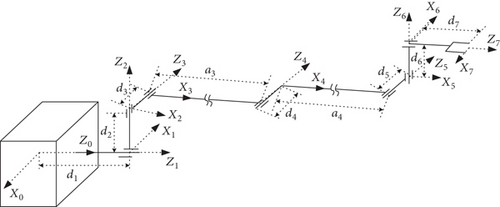
| Joint no. | Torsion angle αi−1 (°) | Link length ai−1 (m) | Joint angle θi (°) | Link offset di (m) |
|---|---|---|---|---|
| 1 | 0 | 0 | 180 | 1.1 |
| 2 | −90 | 0 | −90 | 0.5 |
| 3 | −90 | 0 | 0 | 0.5 |
| 4 | 0 | 5 | 0 | 0.5 |
| 5 | 0 | 5 | 0 | 0.5 |
| 6 | 90 | 0 | 90 | 0.5 |
| 7 | 90 | 0 | 180 | 1.1 |
| Joint no. | Link mass mi (kg) | Link inertia mdiag[Ixxi, Iyyi, Izzi] (kg·m2) | Link centroid position Pcii (m) |
|---|---|---|---|
| 0 | 106 | Diag[106, 106, 106] | [0, 0, 0] T |
| 1 | 42.5 | Diag[0.8854, 0.0531, 0.8854] | [0, 0.25, 0] T |
| 2 | 42.5 | Diag[0.8854, 0.0531, 0.8854] | [0, 0.25, 0] T |
| 3 | 70 | Diag[0.0875, 145.8333, 145.8333] | [2.5, 0, 0] T |
| 4 | 70 | Diag[0.0875, 145.8333, 145.8333] | [2.5, 0, 0] T |
| 5 | 42.5 | Diag[0.8854, 0.8854, 0.0531] | [0, 0, 0.25] T |
| 6 | 42.5 | Diag[0.8854, 0.8854, 0.0531] | [0, 0, 0.25] T |
| 7 | 42.5 | Diag[1.2750, 1.2750, 0.0531] | [0, 0, 0.55] T |
5.1. Motion Planning for the Space Manipulator with Free-Swinging Joint Failure
Aiming at the end-effector trajectory tracking and passive joint regulating tasks and the combination tasks that track end-effector trajectory and limit base attitude deflection when regulating passive joints, we plan motions for the space manipulator based on the first-order nonholonomic constraint. The existence of the first-order nonholonomic constraint is verified, and the motion planning based on kinematic coupling relationships is applied.
5.1.1. End-Effector Trajectory Tracking Task
The variation of is in Figure 3, and the comparison between the actual and the desired end-effector trajectory is in Figure 4.
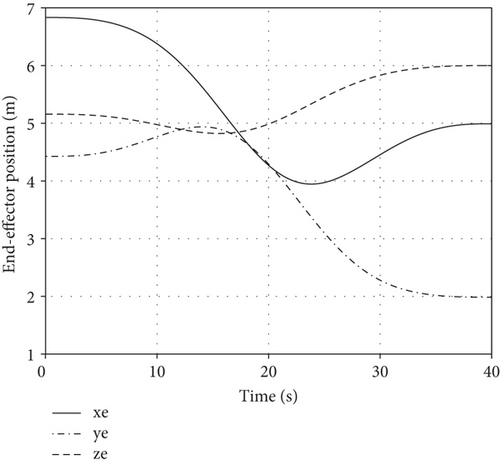
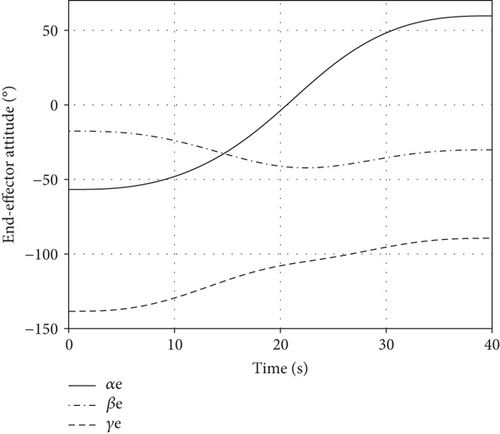

The joint motion is shown in Figure 5.
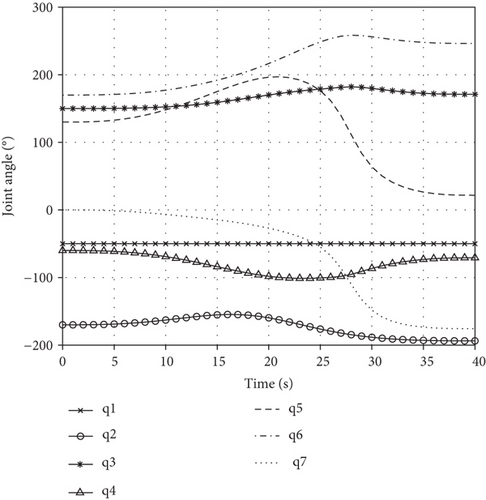
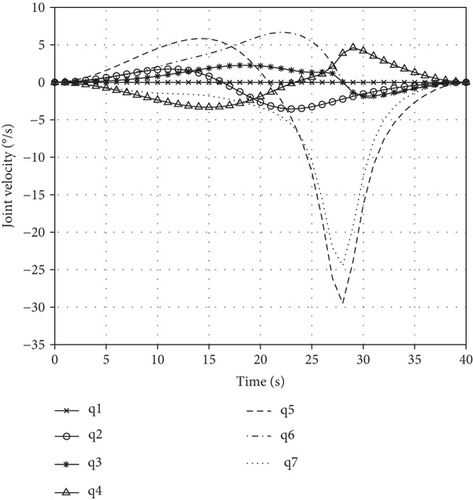
As can be seen from Figures 3–5, end-effector moves along the desired trajectory to arrive at the desired position/attitude, and the joint motion is smooth, so the end-effector trajectory tracking task is accomplished based on motion planning. Velocity of the passive first joint is calculated from equation (15), and its angle is obtained by integral.
5.1.2. Passive Joint Regulating Task
If the number of passive joints is less than or equal to 3, there will be at least 4 healthy joints and the manipulator can perform passive joint regulating task. Assuming the first and fourth joints fail, the initial configuration is θini = [−50°,−170°,150°,−60°,130°,170°,0°]T and the initial base position/attitude is θb_ini = [0, 0, 0, 0, 0, 0]T. The task requires all passive joints to be regulated to θP_des = [−30°,−30°]T in 40 s. However, for the base mass and inertia in Table 2, active joints cannot regulate passive joints because the kinematic coupling degree is seriously insufficient. Therefore, we reset the base mass as m0 = 100 kg and inertia as I0 = diag[100 kg · m2, 100 kg · m2, 100 kg · m2]. Interpolating with the quartic polynomial, variations of θP and are shown in Figure 6.
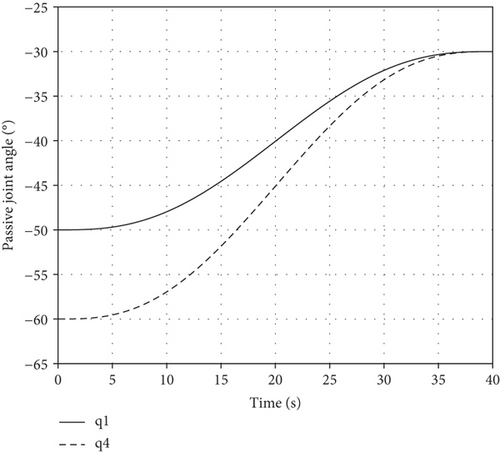
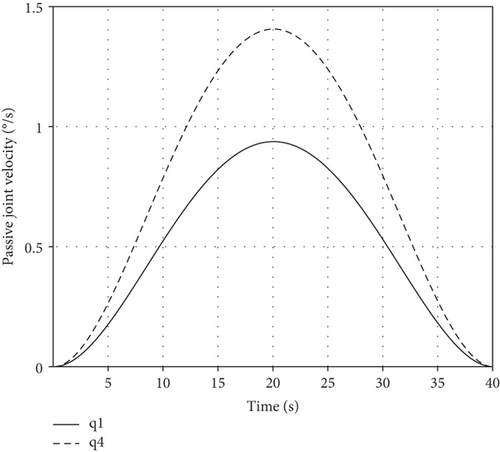
Variations of θA and are shown in Figure 7.
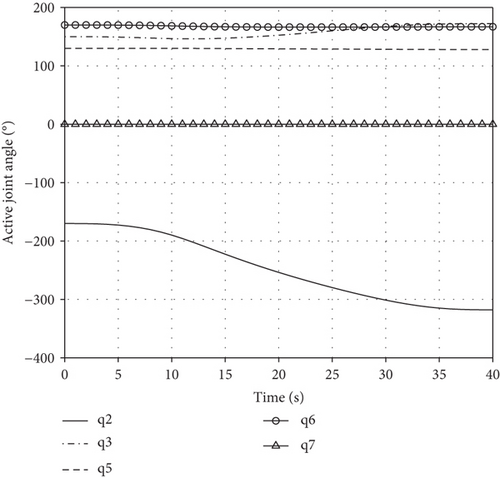
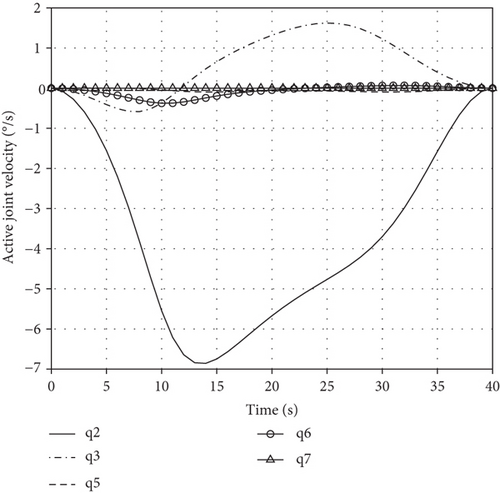
It can be seen that two passive joints are regulated to −30° in 40 s and the motion of active joints is smooth, so the passive joint regulating task is accomplished.
5.1.3. Tracking End-Effector Trajectory When Regulating Passive Joints
If the number of passive joints is less than or equal to 2, there will be at least 5 healthy joints, and active joints can actuate the end-effector to the desired position and regulate passive joints to target angles simultaneously. Assuming the first joint fails, the initial configuration is θini = [−50°,−170°,150°,−60°,130°,170°,0°]T and initial base position/attitude is θb_ini = [0, 0, 0, 0, 0, 0]T. The task requires the end-effector to track a straight trajectory to the desired position xe_des = [4 m, 2 m, 3 m]T and the passive joints to be regulated to θP_des = 0° in 40 s. Base mass and inertia are the same with the passive regulating task. Variations of xe and θP are in Figure 8. The comparison between the actual and the desired trajectory is in Figure 9.
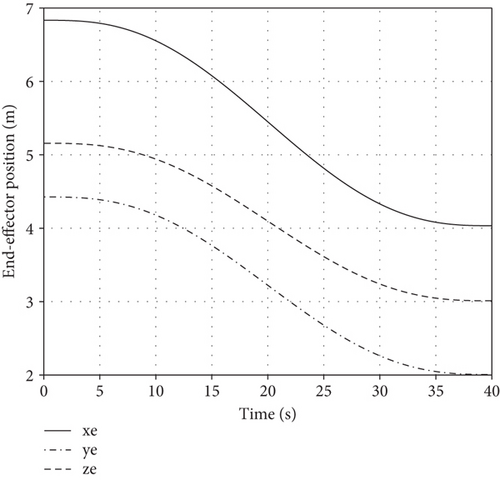
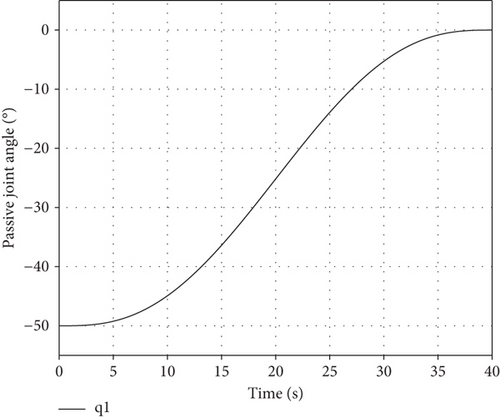
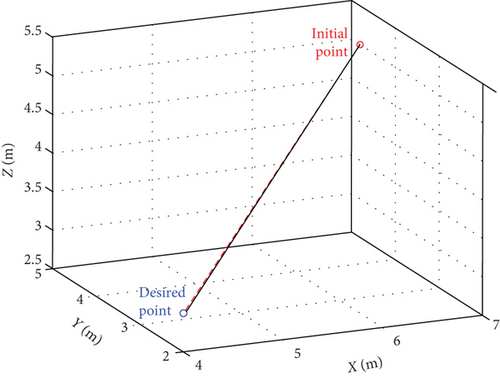
The end-effector arrives at the desired position, and the passive joint is regulated to the target angle in 40 s, so the combination task is accomplished.
5.1.4. Limiting Base Attitude Deflection When Regulating Passive Joints
If the number of passive joints is less than or equal to 2, active joints can eliminate base attitude deflection when regulating passive joints. Assuming the first joint fails, the initial configuration is θini = [−50°,−170°,150°,−60°,130°,170°,0°]T and the initial base position/attitude is θb_ini = [0, 0, 0, 0, 0, 0]T. The task requires the passive joint to be regulated to θP_des = 0°, and base attitude is not disturbed. Base mass and inertia are also the same with the passive regulating task. Variations of θP and θb are in Figure 10.
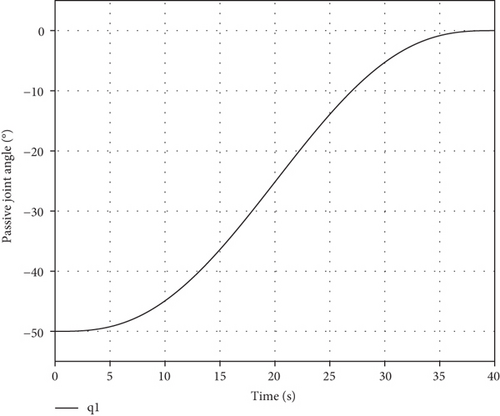
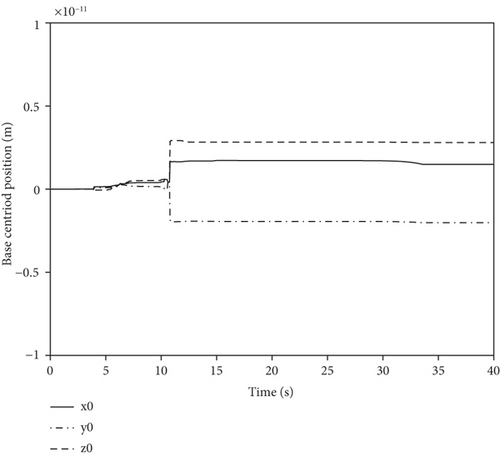
Figure 10 shows that the passive joint converges to 0° in 40 s and the order of magnitudes of base attitude deflection is only 10−11°, so the combination task is accomplished.
During task execution, the values of kinematic coupling indexes are large enough, or else the tasks cannot be accomplished. The simulation results above tell us the space manipulator can execute many typical tasks based on motion planning, which verifies the existence and correctness of the first-order nonholonomic constraint inside the system.
5.2. Calculation and Application Example for Kinematic and Dynamic Coupling Indexes
Aiming at the space manipulator in Figure 2 with free-swinging first joint failure, we give an example for calculating local and global kinematic and dynamic coupling indexes and discuss the differences of values of coupling indexes when selecting different healthy joints as active joints. Then, we analyze the variations of and with the increasing base mass and inertia in particular and point out that when the base mass and inertia are large, passive joint regulation and base deflection limitation cannot be realized through motion planning. In particular, aiming at the passive joint regulating task, we design the control law for based on PD controller and calculate τA to actuate the manipulator to complete the task.
5.2.1. Calculation of Coupling Indexes
Setting the configuration as θ = [−50°,−170°,150°,−60°,130°,170°,0°]T, the base position/attitude is θb = [0, 0, 0, 0, 0, 0]T, the base mass is m0 = 100 kg, and the base inertia is I0 = diag[100 kg · m2, 100 kg · m2, 100 kg · m2]. Assuming that the rotation range of every joint is [θi_min, θi_max] = [−180°, 180°], i = 1, 2, ⋯, 7, the base position deflection limitation is [x0j_min, x0j_max] = [−1 m, 1 m], j = 1, 2, 3 and the attitude deflection limitation is [Ψ0k_min, Ψ0k_max] = [−20°, 20°], k = 1, 2, 3. For the space manipulator with free-swinging first joint failure in Figure 2, selecting all healthy joints as active joints, we calculate the kinematic and dynamic coupling indexes in Table 3.
| Local value | Global value | |||
|---|---|---|---|---|
| Single | Maximum | Minimum | ||
| weA | 0.0016 | 1.9130 | 1.0320 × 10−7 | 0.0085 |
| wPA | 0.1475 | 1.6794 | 0.0082 | 0.1962 |
| wbA | 8.8645 × 10−10 | 8.8645 × 10−6 | 7.4366 × 10−16 | 3.4419 × 10−16 |
| ηPA | 0.6014 | 210.9814 | 0.0165 | 9.8958 |
| ηbA | 0 | 2.1145 × 10−35 | 0 | 0 |
| ηPτ | 0.0079 | 1.6818 × 103 | 2.1660 × 10−4 | 15.9581 |
| ηbτ | 0 | 2.1145 × 10−31 | 0 | 0 |
| ηeτ | 6.8770 × 10−11 | 1.7706 × 10−5 | 2.5938 × 10−16 | 4.2568 × 10−15 |
In Table 3, we make the value which is less than 10−40 equal to zero. Thus, the dynamic coupling degree between active joints and the base is insufficient. In particular, if we lock the fourth and seventh joints, and select other healthy joints as active joints, kinematic and dynamic coupling indexes turn into what is found in Table 4.
| Local value | Global value | |||
|---|---|---|---|---|
| Single | Maximum | Minimum | ||
|
|
3.2168 × 10−18 | 8.4015 × 10−16 | 0 | 7.4488 × 10−35 |
|
|
0.1338 | 2.0813 | 0.0025 | 0.1471 |
|
|
6.4487 × 10−21 | 7.3665 × 10−18 | 0 | 3.7389 × 10−40 |
|
|
0.5825 | 145.4495 | 0.0072 | 8.0662 |
|
|
0 | 1.2862 × 10−36 | 0 | 0 |
|
|
0.0078 | 968.7484 | 1.2646 × 10−4 | 13.3688 |
|
|
0 | 1.0415 × 10−31 | 0 | 0 |
|
|
3.9886 × 10−26 | 1.1401 × 10−14 | 5.7742 × 10−30 | 6.0911 × 10−34 |
As can be seen from Table 4, active joints without the fourth and seventh joints are incapable of actuating the end-effector or controlling the base because the number of active joints is less than the DOF of the end-effector and base. However, values of wPA, ηPA, and ηPτ in Tables 3 and 4 are similar, especially for global indexes, so active joints without the fourth and seventh joints can still regulate passive joints.
The global indexes can not only depict the motion transmission efficiency from active joints to passive units but also serve as the reference to reducing the number of active joints. Users can select the fewest active joints with enough coupling degree to actuate the manipulator.
5.2.2. Effect of Base Mass and Inertia on and
mc is the equivalent mass of the base [30]. We set the values of mc as mc ∈ {101, 102, 103, 104, 105, 106, 107}kg. Assuming the first joint fails and selecting all healthy joints as active joints and taking lgmc as the x-axis, we draw the figures to exhibit the variation of and with mc in Figure 11.
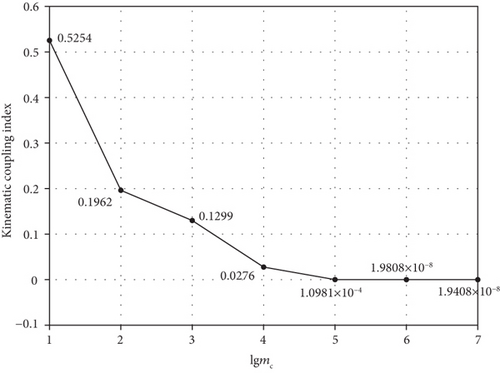
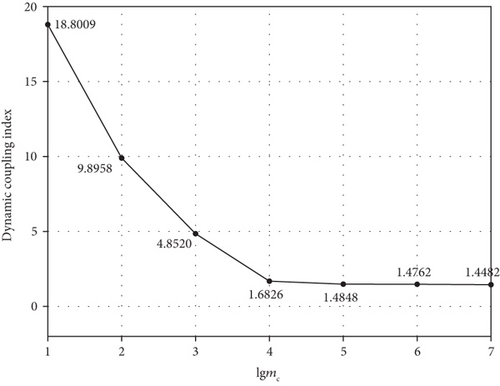
With increase of the base mass and inertia, and decrease continually. When mc > 106, the value of reduces to 10−8 and the magnitudes of change in reach up to 107. But value of stabilizes around 1.4, and the magnitudes of change in are only 101. Thus, active joints cannot effectively regulate passive joints based on motion planning, but can regulate passive joints based on the control method at this moment.
Making e = θP_des − θP, we have . According to the characteristic of the second-order homogeneous differential equation, e exponentially converges to zero. Taking KD = 0.5 and KP = 0.1, and θP are in Figure 12 and θA, , and τA are in Figure 13.
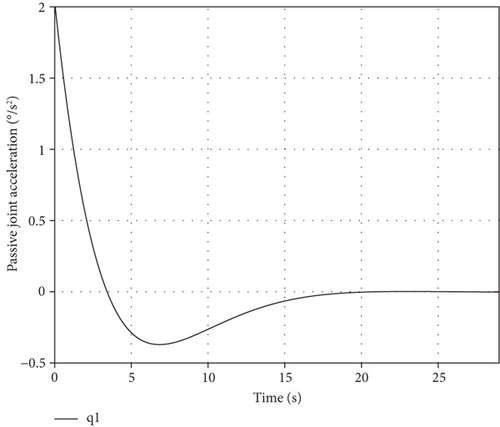
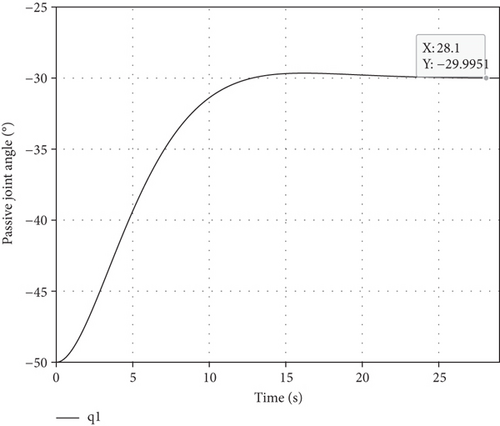
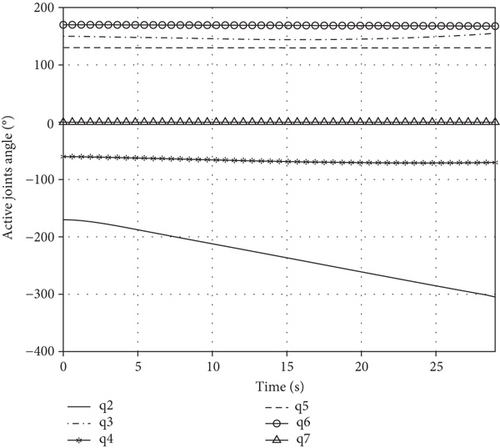
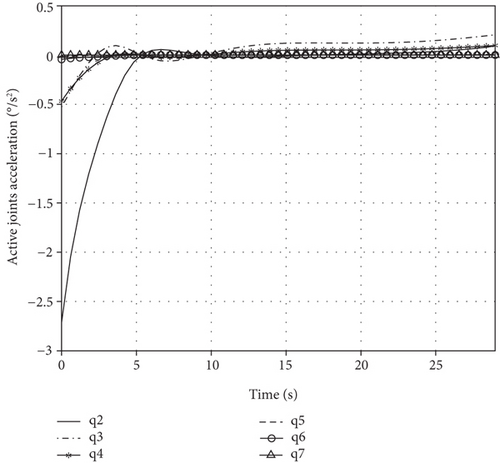

Figure 12 shows that the passive joint is regulated to the desired angle at 28.1 s, and the active joint’s motion and torque are smooth in Figure 13. Thus, the passive joint regulating task is accomplished based on the control method. The PD controller above is only appropriate to the space manipulator with an accurate dynamic model. Considering model uncertainty and external disturbance, a robust control system needs to be designed. But in this paper, we mainly analyze the kinematic and dynamic characteristics of the space manipulator with free-swinging joint failure, instead of a robust controller design. In the future study, we will combine the sliding mode and fuzzy control method to design a controller robust to the bounded unknown disturbance and unmodeled uncertainty for the space manipulator with free-swinging joint failure.
- (1)
The first-order nonholonomic constraint and the second-order nonholonomic constraint do simultaneously exist inside the system of the space manipulator with free-swinging joint failure
- (2)
The kinematic and dynamic coupling indexes proposed in this paper can objectively evaluate kinematic and dynamic coupling degrees from active joints to passive units
- (3)
Many space tasks are either based on motion planning with the first-order nonholonomic constraint or based on a controller design with the second-order nonholonomic constraint
6. Conclusions
- (1)
We explicitly propose kinematic and dynamic modelling methods for the space manipulator with free-swinging joint failure for the first time
- (2)
All kinematic coupling relationships (the first-order nonholonomic constraint) and dynamic coupling relationships (the second-order nonholonomic constraint) inside the system of the space manipulator with free-swinging joint failure are derived
- (3)
For general tasks, we propose the motion planning method based on the first-order nonholonomic constraint and design a control strategy based on the second-order nonholonomic constraint. This is the basis of treatment of free-swinging joint failure
In future research, we will pay more attention to task optimization to make the space manipulator with free-swinging joint failure perform primary and secondary tasks in the meantime. And we further design the control system to be robust to model uncertainty and external disturbance.
Conflicts of Interest
All authors declare that they have no conflicts of interest.
Acknowledgments
This work was supported by the National Natural Science Foundation of China (61403038, 61573066) and Fundamental Research Funds for the Central Universities (2019PTB-012).
Open Research
Data Availability
The data and codes in MATLAB used to support the findings of this study are available from the corresponding author upon request.




